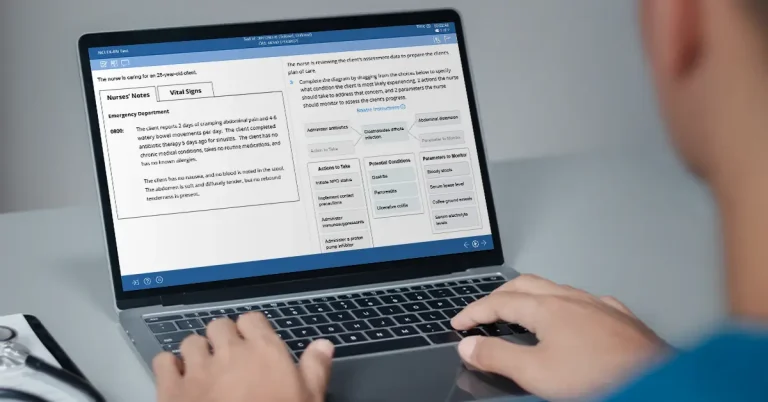Chaney Landgraf, MSN, RN, CNE, CCRN
In my undergraduate and graduate nursing studies, I learned a lot about taking care of others but almost nothing about taking care of myself. Selflessness and altruism are common in nursing, almost worn as badges of honor. I’m sure we’ve all heard a colleague brag about caring for the highest acuity patient without taking a single break, eating, or using the restroom during their twelve-hour shift.
However, we are finding that the “everything and everyone before me” mentality is really a problem. Of course, empathy is not the problem, rather it’s the devaluation of self-care that is troublesome. What can be said with confidence is that the literature shows that when we nurses don’t take care of ourselves, we can’t provide the best care to our patients (Melnyk et al., 2021; Soosova, 2021). Nursing units where staff endorse more stress, fatigue, and burnout also have been found to have more adverse events and near misses in nursing related care (Melnyk et al., 2021; Soosova, 2021).
As nurse educators though, the concern doesn’t just end with the outcomes for individual nurses or patients. Evidence has grown, implicating compassion fatigue, burnout, and work-related stress as major contributors to attrition of early-career nurses, which exacerbates the nursing workforce shortages (Flickman et al., 2013; Shah et al., 2021).
I don’t know about you, but I, as a nurse educator, feel the pressure to graduate more and more students to fill the gaps on the front lines. And frankly, I can feel a little defeated realizing that my students may not be graduating with the skills necessary to have a long and successful career as a bedside nurse. My students are talented, and I believe in their capabilities, as I’m sure many of you feel about your students.
What we see at this juncture is that most established interventions in practice settings aim to address acute or immediate outcomes of compassion fatigue, burnout, and stress. But with more and more nurses experiencing significant work-related stress and reporting an intention to leave the profession, it’s obvious we need to focus more heavily on interventions to prevent these adverse outcomes from reaching the point of no return.
Nurse educators are uniquely positioned to help students prepare for the rigors of practice by learning self-care. So, here are three tips for nurse educators to incorporate self-care concepts into the curriculum and promote resilience:
1. Talk about the importance of sleep and rest for the patient AND the nurse
Many facets of the nursing curriculum include topics relating to sleep and rest — prevention of delirium, stressors contributing to immunosuppression, adverse outcomes in clients with mental health disorders. Take those moments to shift the discussion to the outcomes for a sleep-deprived nurse.
We know that sleep deprivation can impact mental function significantly enough to cause driving impairment, like that occurring when intoxicated (Watson et al., 2015). We also know that sleep duration and quality are moderating factors for reported stress in burnout among graduate students (Allen et al., 2021). So, help your students see the implications for themselves while you’re talking about those related topics in class.
Also, consider modifying deadlines for assignments and activities to encourage appropriate sleep (e.g., making clinical paperwork due at 10:00 p.m. on the nights before clinical rather than the morning of clinical).
2. Incorporate mindfulness-based activities into clinical and didactic experiences
Due to the stressful and high-pressure nature of nursing, mindfulness is a good practice for nursing students to begin understanding long before they are practicing clinicians. This is something nursing educators can contribute to throughout clinicals and didactics. There are a number of activities you can incorporate to contribute to student mindfulness. For example:
* During a particularly stressful or high-stakes exercise or clinical experience, ask students to stop and check in with how they are physically feeling (aka, a body scan). Are they experiencing tension in their necks or shoulders? Are they clenching their jaws? How is their posture?
* Throughout the semester, ask students to journal about their stress levels, their challenges, their triumphs and how all of these things affect them emotionally, mentally, and physically.
* Take breaks during learning experiences to practice mindful breathing with your students. Reiterate the importance of deep breathing as opposed to the shallow breathing that accompanies stress.
These are just a few examples of mindfulness-based activities that can help your students learn to be proactive in their pursuit of self-care.
3. Discuss the “self-medication” epidemic in nursing and the need to seek for the underlying causes
Many nurses find a pattern of substance use with a variety of substances aimed to help them optimize their personal performance and/or deal with the mental or physical consequences of nursing. Maybe it’s a whole pot of coffee before work to stay awake. Maybe it’s just a few alcoholic beverages at the end of the day to help unwind after a rough day. Maybe it’s using controlled substances — substances that were meant for patients — because of a back injury sustained while at work.
An estimated 10% of nurses at some point in their careers will misuse drugs or alcohol. There are a lot of potential reasons for that; high-stress work environments, physical and psychological injuries from work, fatigue, and, in the case of controlled-substance use, relative ease of access through work.
As nurse educators, we have a chance to address these behaviors before they are cemented or progressed and ultimately negatively impact nurses’ careers or patients’ lives. First and foremost, help the student’s learn to be communicative about, and seek help for, their challenges and concerns, just like they would for new patient concerns.
Maybe the student is struggling in class. Rather than languishing in isolation and studying endlessly, encourage them to talk to you about strategies to optimize their work.
Maybe the student had a traumatic experience during clinical. Encourage them to verbalize their feelings and talk to yourself or other faculty mentors (or professionals, if available) about coping strategies.
In order to adequately prepare the next generation of nursing professionals, we must not shy away from difficult topics. Let us face the potential problems and give our students the information, support, and direction they need to prioritize self-care and patient safety.
References
Allen, H. K., Barrall, A. L., Vincent, K. B., & Arria, A. M. (2021). Stress and burnout among graduate students: Moderation by sleep duration and quality. International Journal of Behavioral Medicine, 28(1), 21-28. https://dx.doi.org/10.1007/s12529-020-09867-8
Cao, X., Li, J., & Gong, S. (2021). The relationships of both transition shock, empathy, resilience and coping strategies with professional quality of life in newly graduated nurses. BMC Nursing, 20, 65. https://dx.doi.org/10.1186/s12912-021-00589-0
Flinkman, M., Isopahkala-Bouret, U., & Salantera, S. (2013). Young registered nurses’ intention to leave the profession and professional turnover in early career: A qualitative case study. ISRN Nursing. https://dx.doi.org/10.1155/2013/916061
Melnyk, B. M., Tan, A., Hsieh, A. P., Gawlik, K., Arslanian-Engoren, C., Braun, L. T., Dunbar, S., Dunbar-Jacob, J., Lewis, L. M., Millan, A., Orsolini, L., Robbins, L. B., Russell, C. L., Tucker, S., & Wilbur, J. (2021). Critical care nurses’ physical and mental health, worksite wellness support, and medical errors. American Journal of Critical Care, 30(3), 176-184. https://dx.doi.org/10.4037/ajcc2021301
Shah, M. K., Gandrakota, N., & Cimiotti, J. P. (2021). Prevalence of and factors associated with nurse burnout in the US. JAMA Network Open, 4(2), e2036469. doi:10.1001/jamanetworkopen.2020.36469
Soosova, M. S. (2021). Association between nurses’ burnout, hospital patient safety climate, and quality of nursing care. Central European Journal of Nursing and Midwifery, 12(1), 245-256. https://dx.doi.org/ 10.15452/CEJNM.2021.12.0039
Michael Kaliszewski (n.d.). Why Nurses are at a Higher Risk for Substance Abuse. American Addiction Centers. Retrieved 5/13/2021 from https://americanaddictioncenters.org/medical-professionals/nurses-at-a-higher-risk-for-substance-abuse Watson, N.F., Morgenthaler, T., Chervin, R., Carden, K., Kirsch, D., Kristo, D., Malhotra, R., Martin, J., Ramar, K., Rosen, I., Weaver, T., & Wise, M. (2015). Confronting drowsy driving: the american academy of sleep medicine perspective. Journal of Clinical Sleep Medicine, 11(11), 1335-13362015;11(11):1335–1336..





